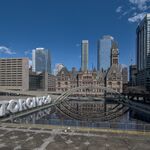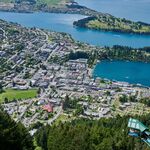nfitz
Superstar
I wonder what the 1966 and 1976 censuses were?The highest count for the old City was in the 1971 census: 713,000.
http://www.demographia.com/db-cancityhist.htm
|
|
|
I wonder what the 1966 and 1976 censuses were?The highest count for the old City was in the 1971 census: 713,000.
http://www.demographia.com/db-cancityhist.htm
I think most (a very large majority) of Tokyo's land mass is <5 storeys. A majority is 2-3 storey, either homes or small apartments, it's hard to tell. Near transit stations, the core areas and along major boulevards, you might be seeing a mix of midrises and smaller highrises like in the picture, but even in those areas you have 2-4 storey buildings.Yea, but much of Tokyo looks like this.

Which, despite the absence of many high-rises, is still much denser than would be considered acceptable in most of Toronto.
Toronto talks a good game on density but as long as intensification is limited to brownfield sites, which ultimately occupy a pretty small part of the city, there's not all that much room to grow.
I think most (a very large majority) of Tokyo's land mass is <5 storeys. A majority is 2-3 storey, either homes or small apartments, it's hard to tell. Near transit stations, the core areas and along major boulevards, you might be seeing a mix of midrises and smaller highrises like in the picture, but even in those areas you have 2-4 storey buildings.
Keep in mind that between 1966 and 1971 censuses, Toronto annexed Forest Hill and Swansea.I wonder what the 1966 and 1976 censuses were?

480 to 19,225... although I just realized the 1956/1961 boundaries for the Thorncliffe census tract were different and included a bit of Leaside around Leacrest Rd. Excluding that, the 1956 population would probably have been around 5 as you said... which would actually translate to a 100,000%+ increase.I love the +3905.2 percent. So I take it that neighbourhood went from 5 people to 19,526 or something like that?
I was a bit surprised at how much population Palmerston-Little Italy-Harbord Village lost. I guess it experienced more significant gentrification than adjacent neighbourhoods?
480 to 19,225... although I just realized the 1956/1961 boundaries for the Thorncliffe census tract were different and included a bit of Leaside around Leacrest Rd. Excluding that, the 1956 population would probably have been around 5 as you said... which would actually translate to a 100,000%+ increase.
@W.K. Lis: The 2nd floor bathroom was for the 2nd floor unit(s) or was it also for the main floor unit? So there are relatively few of those now? How about basement apartments? I would have thought with the relatively small household sizes today, that many of these houses would have remained multi-family, just with smaller households. Anyways, Little Italy still gained about 2-3% in population from 1951 to 1956.
I'm guessing the losses started in the 60s, then got steeper in the 70s.





